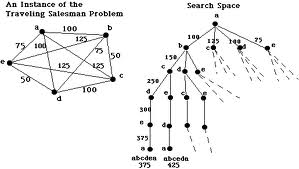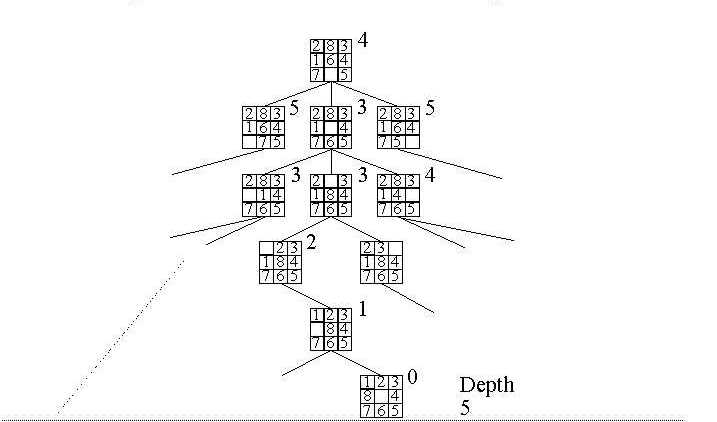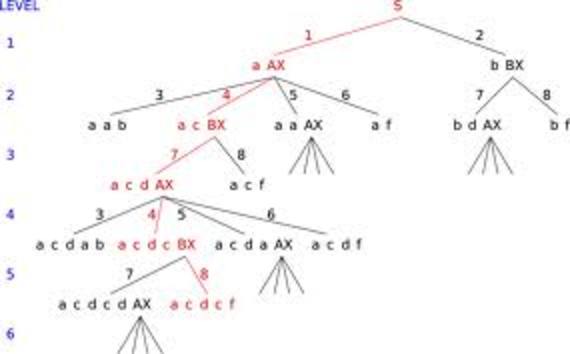
State Space
Weiss Ch. 10.5. (not really...)
Weiss's title is "Backtracking Algorithms". For me, backtracking is a
particular, memory-saving implementation of depth-first graph search.
His game-playing example is not exactly backtracking. So let's take
him to mean "Graph Search", which is a highly practical and basic idea
with many implementations and ideas running around, especially driven
by artificial intelligence.
Often a problem or a situation is modeled computationally or
mathematically by a state. E.g. quantum state, state vector of
a rocket: orientation, location, speed as in
(A, B, C, X,Y,Z, X', Y', Z'), location of pieces on a chess-board, location
of a salesman on a map, etc. In the relevant domain, an
operator changes the state (pushes a pawn, accelerates, goes to
next city...).
The abstract, often infinite, set of all states, including the connections
between them induced by operators, is the
state space of a problem. A (very) early and
still-central AI model of human problem solving uses the ideas so
far, along with an
initial state for the problem and a
goal state to be achieved.
E.g. SAT: initial state is a set of unassigned variables.
There's a data base of
logical clauses, and
goal state is a set of variable assignments (P is T, Q is F)
that satisfies the
clauses. Or there's an initial stacking of blocks and the goal is
another such configuration. Etc.
SFS: You're a robot moving located on a discrete grid sitting on a
NSEW
world coordinate system. You have two
operators: "move one N" and "move one E". Draw the state space
(also show the operators that transform states).
Problem Solving
Problem solving is the process of navigating the state space (graph) by
applying an operator to the current state, in search of the goal.
The state space is the totality of possibilities, and the
search results in a search tree, which to an
observer looks like a tree of states that grows with exploration: it
has the initial state as root and the hope is to find the goal, which
would be a leaf. The path from root to goal is the sequence of
operations needed to achieve the goal (but sometimes we don't care how we
did it.)
Usually (and for us) the search tree is not an explicit data
structure.
It is implicit in the recursive-calling structure of a BFS or DFS
variant.
The "state of the node" is actually preserved in the local variables
of one invocation of the search program, which itself figures out the
successors of its argument state given the available operators
and recursively calls itself to explore them. If its argument is
actually a goal state, it can declare victory and quit, or return up
the calling tree along the successful search path. This is good for
us... the programming language manages our tree for us.
Examples: TSP state space and search tree

8-puzzle search tree

Parsing a sentence as search

State Space Search Representation
First, formalize at the appropriate level: usually, for this sort of
problem, what any normal non-wise-ass 10 year old would do.
In a problem about pouring
water from jugs to get some even number of gallons, we don't worry
about
evaporation. We don't consider the operation of pouring a random
amount, or pouring a fractional amount. Operations complete
successfully, etc.
The formalism interacts with the representations, especially with the
state. From the state we need to be able quickly to generate
successors that result from
applying operations, and to check conditions like "is this
a goal state?", and to compute the "goodness" of a state (often
an approximation to how close to the goal we are) or its "badness"
(e.g. the cost so far to get there). We need good representations.
Three Representations
State: As simple and efficient as possible. Vector, list, etc
is good. Worth some thought... E.g. NxN array sucks for N-queens.
Tree Node: Probably a good idea to encapsulate the state along with
other ancillary information like parent pointers, level of this node
in the search, costs and goodness measures....
Search Tree: For some problems need to extract path from
initial to goal state. That would imply for BFS (coming up soon) that the tree nodes
on the queue have parent pointers. In DFS the tree is in the calling
sequence, so constructing the path needs to keep some
information (the state or the operator used)
from every level when returning from goal.
State Space Search Control: Weak Methods
Weak search methods ignore effort-saving sanity checks and knowledge
about
the domain.
Search trees are often immense (Chess, say) and exponentially-behaved
Operations = (branching factor)levels.
AI researchers were originally
interested in the human side of problem-solving, so wondered how we
achieve the effect of "brute force" exponential search.
We have several choices in searching a state-space (graph), with
predictable trade-offs. This is CSC 242 material, good book is
Artificial Intelligence: a Modern Approach (3rd ed.), Russell and
Norvig.
Depth-first search tends to generate deep skinny trees. It needs minimal
(linear in depth)
working memory (for generated sucessors and recursive calls) but can
dive down to infinity. Given a node, DFS checks for end
conditions (e.g. found goal, at max. allowed depth) if it's done it returns
status (eg success or suspended).
Else it generates successors: if it calls self as each is
generated, that is technically backtracking. If it generates
and saves them all at once, then works thru them that's just DFS.
Breadth-first search generates maximally-bushy and minimally
deep
searches. It uses iteration and a queue, not recursion. It is exponentially
expensive in working memory (active nodes). Conservative: does not miss any
possibilities at any depth, but explores all successors to all nodes
at the current depth before looking deeper (forward) into the search.
Depth-limited search is a variant of DFS or BFS to control
its depth and so avoid infinite searches. So we'd talk about "DFS of
depth 5", say.
Uniform-cost search is BFS based on cost; it is BFS if
the modelled cost of applying operators is uniform. BFS is not recursive, it's an iteration until some
stopping condition (depth limit, find goal). Each iteration takes a
state off a single "job queue", checks if it can stop, else generates its
successors,
puts them on the queue, and iterates.
Bi-directional search: We know the goal, and the start, so why
not search both directions? May be possible or useful depending on
the problem.
Iterative deepening combines characteristics of
DFS and BFS at a small multiple of
the cost. Half the nodes in a
binary tree are at the leaves, so it's not that expensive to
do DFS to level N, then just repeat the DFS to level N+1, etc. BFS
conservative
behavior
with DFS memory cost.
State Space Search Control: Heuristic Search
Why not
take advantage of general principles or domain-knowledge to prune
the search
tree, avoid predicatably useless work?
There are universal principles that don't compromise finding the
goal (e.g. avoid loops, α-β pruning (for games), guarantee some motion
by avoiding useless operators).
Then there are
domain-dependent principles: possibly an operator has
a cost , so we're into minimum-cost search. Last,
knowledge or dictates from the domain may give heuristics, or
rules of thumb, to guide the search ("don't develop your queen before
your knights", "don't draw to an inside straight", "place big pieces
before smaller ones", etc.). Operator cost and
perceived goodness (from heuristics or other metrics) may be combined
into a heuristic, best-first search scheme beloved of AI
people. The A* best-first algorithm is the canonical heuristic search --
it has good properties: uses domain knowledge, prunes the tree, but
it's guaranteed to find the optimal
path to the goal.
j
Games and State Space Search
Weiss presents the domain of games for graph search. Lots of fun,
rather trendy perhaps. I'm reluctant to pursue the topic
because of the more
complex nature of the abstraction (two opposing players).
In 172, we don't need problems that fight back.
Usually games use heuristic search in which the game position (state)
is assigned a
value (say it's positive for White), with the assumption that what's good for
White is exactly that bad for Black, and vice-versa (they're zero-sum). Thus when
players take turns, they are trying to push the value of the
position in opposite directions. This leads to minimax search,
of early game theory fame (Von Neumann and Morgenstern). White tries
to maximize his goodness, Black to minimize it, and they take turns
doing that.
Minimax allows another famous general pruning principle called
α-β pruning. It says, in effect: "You'd be crazy to
explore this line of play because you can tell right now he'll never
make the move that allows it-- he can see it's too dangerous, he can
do better, etc.".
Examples and Laboratory Assignments
For all these problems, we have a "state" describing the situation
(set of variables with values, values in an array,...)
Also an initial and (set of) goal state(s). The search tree
may be made of nodes that gather together useful auxiliary information
about a state.
The basic
routine to process node in a search:
- Use hash table to check if this state has already been created and
visited (it's in the "explored set" or "closed list").
If so, return.
-
If not, if it's a goal state, declare success and return.
-
Else generate sucessor nodes by applying legal operators to the
current state to get successor nodes. Call self on each (for DFS) or
enqueue them (for BFS), in some order.
-
Use costs, heuristics, state goodness measures, to rank successors and
pick the best-looking to expand next.
Finally, present the relevant answer to the user: a sequence of operations, a
final state, failure, whatever.
Examples and Laboratory Assignments
The 8 Puzzle
We saw this one's partial search tree above. Push tiles to rearrange
8 tiles in 3x3 frame with a space, transforming initial to goal state.
Best to formalize the single operation as "move the space". A state has
various numbers of successors depending on where the space is.
I don't know best representation but a 3x3 array doesn't sound crazy.
As I recall, only half the state space is reachable from an initial
state, so if you're going for
1 2 3
4 b 5
6 7 8
from a random
starting state it'd be impossible half the time.
Clearly an infinite space, so raw DFS dangerous. An inverse "goodness" is easy
to come up with though: "How many tile moves to a solution?" Here the
fewer the better.
Important: Admissible heuristics
do not over estimate the work to find a solution: One can sometimes
think of them as the work for an easier version of the problem.
The idea is to estimate the real work as closely as possible: but if
it's
over-estimated, there's a chance that a sub-optimal solution that
(mistakenly) looked easier will be found first.
Two admissible heuristics:
H1. The number of misplaced tiles, or better,
H2. the sum of all Manhattan (= city-block metric, = sum of row+col diffs)
distances of the tiles from their goal position.
H2. is better since it more accurately (under)-estimates the work
involved,
thus does more pruning than H1 without possibly pruning away the
optimal path to the goal.
Admissible Heuristics
Initial ---> Final
1 2 3 b 8 7
4 5 6 6 5 4
7 8 b 3 2 1
H1: All 8 tiles out of place, so work at least 8
(teleports!). Underestimates by a lot, too optimistic to help much in pruning.
H2: Manhattan distance each tile must travel (right thru obstacle
tiles, so underestimates): 1,4: 2,2: 3,4: ... 5,0:...8,2 total is 20.
Actual work: spin the outer ring CCW 4 times = 28 moves.
Jugs
There are zillions of these puzzles out there, pretty much no two
alike. It seems the "typical assumptions" are: there is an infinite
source of water and a finite set of jugs of integer capacities, and
water can be poured back and forth, on the ground, etc. Achieve a
state
with specified quantities of water in the jugs.
Sort of a fun design process to minimize the representation and operations involved.
For any particular problem, one can have a "state" consisting of the
volumes in variables Jug1, jug2, ... jugN, say. The basic
routine to process a node:
Checks if this state has already been created and
visited (it's in the "explored set" or "closed list") -- use a hash table.
If not, if it's a goal state, declare success and quit.
Else
remember the state in local variable(s), then loop
thru all possible operators to generate successors and for each,
in some order, call self on the result.
For the general N-jug problem, don't want to have to name an arbitrary
number of variables, that's what arrays are for.
So the state is an N-vector of jug
volumes.
I added an N+1st jug of infinite capacity that
could serve as faucet and drain both.
Then it seems we only need one
operation, "pour from jug A into B", which only has one interesting
case, the rest (fill from and dump to resevoir)
having easy effects on the current state. This is a pretty
significant and elegant
simplification, though I say it who shouldn't. Sign of a good rep.
if it simplfies your operators. Free to you.
In the "don't do useless work" department, the operator returns
success (and does nothing)
for:
1. A is empty
2. A = B (don't pour into yourself
3. B full already
Specific standard problems. Three jugs of 12, 8, and 3 gallons. Goal
is
one gallon in any jug. Easier: Two jugs of 5 and 3, your job is to
produce 4.
Find more if you like, shouldn't be hard. Make some up. Impress us.
I've
wondered (and the question should have occurred to you ;-})
how to answer this: "Given a set of jug sizes, and
you want to get X gallons, is it possible?" Better would be "For what
X is it possible?".
Slightly non-standard but easily formalizable with slightly modified
operators. You could automate Puzzle 3 and let your search program do
the optimizing...
Dividing The Waters.
Here's another couple:
Sharing water and
balsam
Etc. etc.
Examples and Laboratory Assignments
Missionary and Cannibals (Cannabis, Cannonballs)
3 missionaries and 3 cannibals are on one side of a river with a boat
that can hold 1 or 2 people. How to get everyone across without ever
leaving a group of missionaries outnumbered by cannibals on either side?
The boat can't cross with no one on board.
Very early AI paper (Amarel 1968).
Draw the complete state space (pretty simple). Write the program
finding the optimal solution.
What about N individuals in each tribe? Does a general method emerge from our
N=3 example?
Last update: 7.25.13



